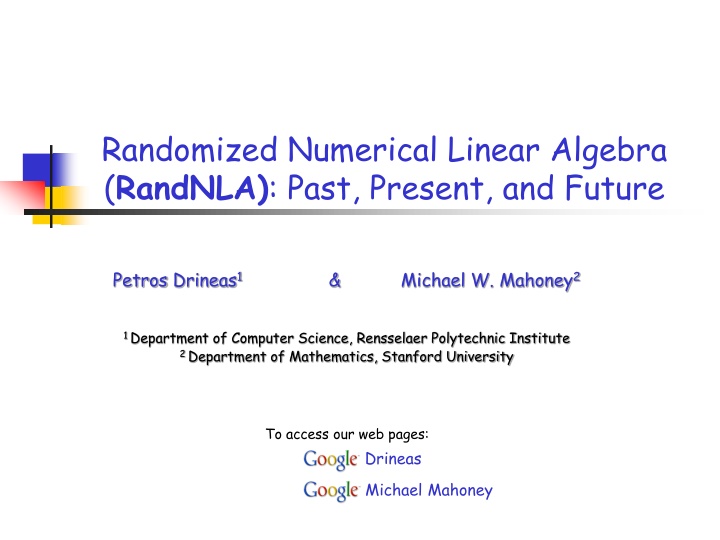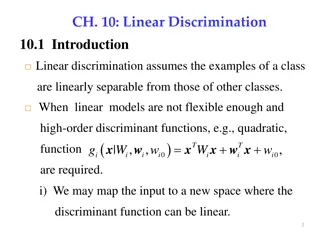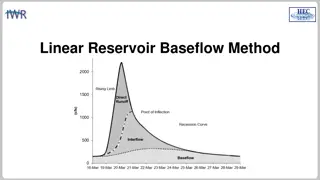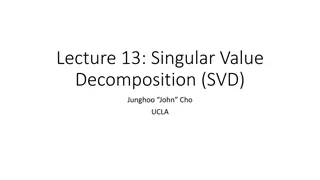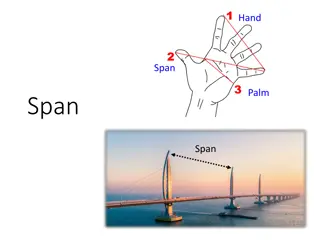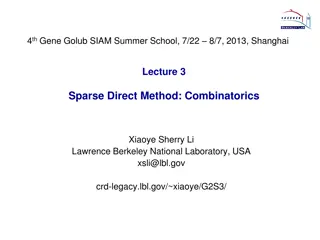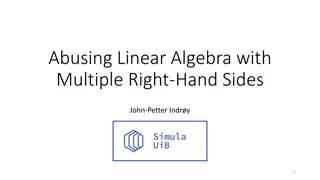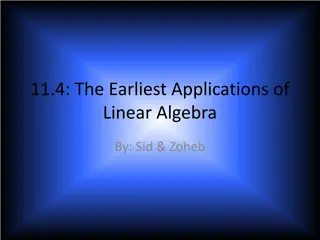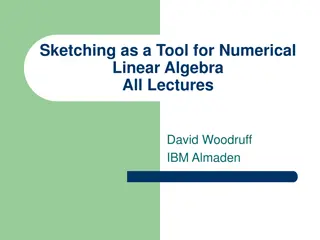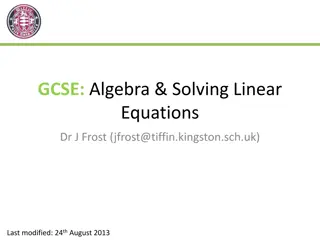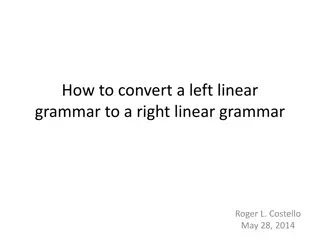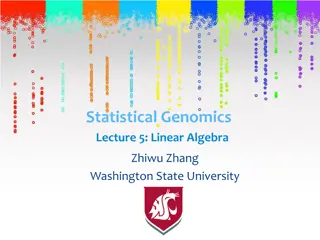Randomized Numerical Linear Algebra (RandNLA)
Delve into the world of RandNLA, where randomization and sampling techniques are utilized to design accurate algorithms for handling massive matrices and computationally complex problems. Learn about sampling rows/columns, matrix perturbation theory, and its applications in Big Data, theoretical computer science, and numerical linear algebra.
Download Presentation

Please find below an Image/Link to download the presentation.
The content on the website is provided AS IS for your information and personal use only. It may not be sold, licensed, or shared on other websites without obtaining consent from the author.If you encounter any issues during the download, it is possible that the publisher has removed the file from their server.
You are allowed to download the files provided on this website for personal or commercial use, subject to the condition that they are used lawfully. All files are the property of their respective owners.
The content on the website is provided AS IS for your information and personal use only. It may not be sold, licensed, or shared on other websites without obtaining consent from the author.
E N D
Presentation Transcript
Randomized Numerical Linear Algebra (RandNLA): Past, Present, and Future Petros Drineas1 & Michael W. Mahoney2 1 Department of Computer Science, Rensselaer Polytechnic Institute 2 Department of Mathematics, Stanford University To access our web pages: Drineas Michael Mahoney
Why RandNLA? Randomization and sampling allow us to design provably accurate algorithms for problems that are: Massive (matrices so large that can not be stored at all, or can only be stored in slow memory devices) Computationally expensive or NP-hard (combinatorial optimization problems such as the Column Subset Selection Problem)
RandNLA: sampling rows/columns Randomized algorithms By (carefully) sampling rows/columns of a matrix, we can construct new, smaller matrices that are close to the original matrix (w.r.t. matrix norms) with high probability. By preprocessing the matrix using random projections, we can sample rows/columns much less carefully (uniformly at random) and still get nice bounds with high probability.
RandNLA: sampling rows/columns Randomized algorithms By (carefully) sampling rows/columns of a matrix, we can construct new, smaller matrices that are close to the original matrix (w.r.t. matrix norms) with high probability. By preprocessing the matrix using random projections, we can sample rows/columns much less carefully (uniformly at random) and still get nice bounds with high probability. Matrix perturbation theory The resulting smaller matrices behave similarly (in terms of singular values and singular vectors) to the original matrices thanks to the norm bounds. Structural results that decouple the randomized part from the matrix perturbation part are important in the analyses of such algorithms.
Interplay Applications in BIG DATA (Data Mining, Information Retrieval, Machine Learning, Bioinformatics, etc.) Theoretical Computer Science Randomized and approximation algorithms Numerical Linear Algebra Matrix computations and linear algebra (ie., perturbation theory)
Roadmap of the tutorial Focus: sketching matrices (i) by sampling rows/columns and (ii) via random projections. Machinery: (i) Approximating matrix multiplication, and (ii) decoupling randomization from matrix perturbation. Overview of the tutorial: (i) Motivation: computational efficiency, interpretability (ii) Approximating matrix multiplication (iii) From matrix multiplication to CX/CUR factorizations and approximate SVD (iv) Improvements and recent progress (v) Algorithmic approaches to least-squares problems (vi) Statistical perspectives on least-squares algorithms (vii) Theory and practice of: extending these ideas to kernels and SPSD matrices (viii) Theory and practice of: implementing these ideas in large-scale settings
Areas of RandNLA that will not be covered in this tutorial Element-wise sampling Introduced by Achlioptas and McSherry in STOC 2001. Current state-of-the-art: additive error bounds for arbitrary matrices and exact reconstruction under (very) restrictive assumptions (important breakthroughs by Candes, Recht, Tao, Wainright, and others) To do:Efficient, optimal, relative-error accuracy algorithms for arbitrary matrices. Solving systems of linear equations Almost optimal relative-error approximation algorithms for Laplacian and Symmetric Diagonally Dominant (SDD) matrices (Spielman, Teng, Miller, Koutis, and others). To do: progress beyond Laplacians.
Areas of RandNLA that will not be covered in this tutorial Element-wise sampling Introduced by Achlioptas and McSherry in STOC 2001. Current state-of-the-art: additive error bounds for arbitrary matrices and exact reconstruction under (very) restrictive assumptions (important breakthroughs by Candes, Recht, Tao, Wainright, and others) To do:Efficient, optimal, relative-error accuracy algorithms for arbitrary matrices. Solving systems of linear equations Almost optimal relative-error approximation algorithms for Laplacian and Symmetric Diagonally Dominant (SDD) matrices (Spielman, Teng, Miller, Koutis, and others). To do: progress beyond Laplacians. There are surprising (?) connections between all three areas (row/column sampling, element-wise sampling, and solving systems of linear equations).
Roadmap of the tutorial Focus: sketching matrices (i) by sampling rows/columns and (ii) via random projections. Machinery: (i) Approximating matrix multiplication, and (ii) decoupling randomization from matrix perturbation. Overview of the tutorial: (i) Motivation: computational efficiency, interpretability (ii) Approximating matrix multiplication (iii) From matrix multiplication to CX/CUR factorizations and approximate SVD (iv) Improvements and recent progress (v) Algorithmic approaches to least-squares problems (vi) Statistical perspectives on least-squares algorithms (vii) Theory and practice of: extending these ideas to kernels and SPSD matrices (viii) Theory and practice of: implementing these ideas in large-scale settings
Human genetics Single Nucleotide Polymorphisms: the most common type of genetic variation in the genome across different individuals. They are known locations at the human genome where two alternate nucleotide bases (alleles) are observed (out of A, C, G, T). SNPs AG CT GT GG CT CC CC CC CC AG AG AG AG AG AA CT AA GG GG CC GG AG CG AC CC AA CC AA GG TT AG CT CG CG CG AT CT CT AG CT AG GG GT GA AG individuals GG TT TT GG TT CC CC CC CC GG AA AG AG AG AA CT AA GG GG CC GG AA GG AA CC AA CC AA GG TT AA TT GG GG GG TT TT CC GG TT GG GG TT GG AA GG TT TT GG TT CC CC CC CC GG AA AG AG AA AG CT AA GG GG CC AG AG CG AC CC AA CC AA GG TT AG CT CG CG CG AT CT CT AG CT AG GG GT GA AG GG TT TT GG TT CC CC CC CC GG AA AG AG AG AA CC GG AA CC CC AG GG CC AC CC AA CG AA GG TT AG CT CG CG CG AT CT CT AG CT AG GT GT GA AG GG TT TT GG TT CC CC CC CC GG AA GG GG GG AA CT AA GG GG CT GG AA CC AC CG AA CC AA GG TT GG CC CG CG CG AT CT CT AG CT AG GG TT GG AA GG TT TT GG TT CC CC CG CC AG AG AG AG AG AA CT AA GG GG CT GG AG CC CC CG AA CC AA GT TT AG CT CG CG CG AT CT CT AG CT AG GG TT GG AA GG TT TT GG TT CC CC CC CC GG AA AG AG AG AA TT AA GG GG CC AG AG CG AA CC AA CG AA GG TT AA TT GG GG GG TT TT CC GG TT GG GT TT GG AA Matrices including thousands of individuals and hundreds of thousands if SNPs are available.
HGDP data 1,033 samples 7 geographic regions 52 populations The Human Genome Diversity Panel (HGDP) Cavalli-Sforza (2005) Nat Genet Rev Rosenberg et al. (2002) Science Li et al. (2008) Science
HGDP data 1,033 samples 7 geographic regions 52 populations CEU TSI JPT, CHB, & CHD HapMap Phase 3 data 1,207 samples 11 populations MEX GIH ASW, MKK, LWK, & YRI HapMap Phase 3 The Human Genome Diversity Panel (HGDP) Cavalli-Sforza (2005) Nat Genet Rev Rosenberg et al. (2002) Science Li et al. (2008) Science The International HapMap Consortium (2003, 2005, 2007) Nature
HGDP data 1,033 samples 7 geographic regions 52 populations CEU TSI JPT, CHB, & CHD HapMap Phase 3 data 1,207 samples 11 populations MEX GIH ASW, MKK, LWK, & YRI We will apply SVD/PCA on the (joint) HGDP and HapMap Phase 3 data. HapMap Phase 3 The Human Genome Diversity Panel (HGDP) Matrix dimensions: 2,240 subjects (rows) 447,143 SNPs (columns) Dense matrix: over one billion entries Cavalli-Sforza (2005) Nat Genet Rev Rosenberg et al. (2002) Science Li et al. (2008) Science The International HapMap Consortium (2003, 2005, 2007) Nature
Paschou, Lewis, Javed, & Drineas (2010) J Med Genet Europe Middle East Gujarati Indians South Central Asia Mexicans Africa Oceania America East Asia Top two Principal Components (PCs or eigenSNPs) (Lin and Altman (2005) Am J Hum Genet) The figure renders visual support to the out-of-Africa hypothesis. Mexican population seems out of place: we move to the top three PCs.
Paschou, Lewis, Javed, & Drineas (2010) J Med Genet Africa Middle East S C Asia & Gujarati Europe Oceania East Asia America Not altogether satisfactory: the principal components are linear combinations of all SNPs, and of course can not be assayed! Can we find actual SNPs that capture the information in the singular vectors? Formally: spanning the same subspace.
Issues Computing large SVDs: computational time In commodity hardware (e.g., a 4GB RAM, dual-core laptop), using MatLab 7.0 (R14), the computation of the SVD of the dense 2,240-by-447,143 matrix A takes about 12 minutes. Computing this SVD is not a one-liner, since we can not load the whole matrix in RAM (runs out-of-memory in MatLab). We compute the eigendecomposition of AAT. In a similar experiment, we had to compute the SVD of a 14,267-by-14,267 matrix to analyze mitochondrial DNA from 14,267 samples from approx. 120 populations in order to infer the relatedness of the Ancient Minoans to Modern European, Northern African, and Middle Eastern populations. (Hughey, Paschou, Drineas, et. al. (2013) Nature Communications) Obviously, running time is a concern. Machine-precision accuracy is NOT necessary! Data are noisy. Approximate singular vectors work well in our settings.
Issues (contd) Selecting good columns that capture the structure of the top PCs Combinatorial optimization problem; hard even for small matrices. Often called the Column Subset Selection Problem (CSSP). Not clear that such columns even exist. The two issues: (i) Fast approximation to the top k singular vectors of a matrix, and (ii) Selecting columns that capture the structure of the top k singular vectors are connected and can be tackled using the same framework.
SVD decomposes a matrix as The SVD has strong optimality properties. Top k left singular vectors It is easy to see that X = UkTA. SVD has strong optimality properties. The columns of Uk are linear combinations of up to all columns of A.
The CX decomposition Mahoney & Drineas (2009) PNAS Carefully chosen X Goal: make (some norm) of A-CX small. c columns of A, with c being as close to k as possible Why? If A is an subject-SNP matrix, then selecting representative columns is equivalent to selecting representative SNPs to capture the same structure as the top eigenSNPs. We want c as small as possible!
CX decomposition c columns of A, with c being as close to k as possible Easy to prove that optimal X = C+A. (with respect to unitarily invariant norms; C+ is the Moore-Penrose pseudoinverse of C). Thus, the challenging part is to find good columns (SNPs) of A to include in C. From a mathematical perspective, this is a combinatorial optimization problem, closely related to the so-called Column Subset Selection Problem (CSSP); the CSSP has been heavily studied in Numerical Linear Algebra.
Our objective for the CX decomposition We would like to get theorems of the following form: Given an m-by-n matrix A, there exists an efficient algorithm that picks a small number of columns of A such that with reasonable probability:
Our objective for the CX decomposition We would like to get theorems of the following form: Best rank-k approximation to A: Ak = UkUkTA Given an m-by-n matrix A, there exists an efficient algorithm that picks a small number of columns of A such that with reasonable probability:
Our objective for the CX decomposition We would like to get theorems of the following form: low-degree polynomial in m, n, and k Given an m-by-n matrix A, there exists an efficient algorithm that picks a small number of columns of A such that with reasonable probability: Close to k/ constant, high, almost surely, etc.
Roadmap of the tutorial Focus: sketching matrices (i) by sampling rows/columns and (ii) via random projections. Machinery: (i) Approximating matrix multiplication, and (ii) decoupling randomization from matrix perturbation. Overview of the tutorial: (i) Motivation: computational efficiency, interpretability (ii) Approximating matrix multiplication (iii) From matrix multiplication to CX/CUR factorizations and approximate SVD (iv) Improvements and recent progress (v) Algorithmic approaches to least-squares problems (vi) Statistical perspectives on least-squares algorithms (vii) Theory and practice of: extending these ideas to kernels and SPSD matrices (viii) Theory and practice of: implementing these ideas in large-scale settings
Approximating Matrix Multiplication Problem Statement Given an m-by-n matrix A and an n-by-p matrix B, approximate the product A B, OR, equivalently, Approximate the sum of n rank-one matrices. Each term in the summation is a rank-one matrix B(i) A(i) i-th row of B i-th column of A
A sampling approach B(i) A(i) i-th row of B i-th column of A Algorithm 1. Fix a set of probabilities pi, i =1 n, summing up to 1. 2. For t= 1 c, set jt = i, where P(jt = i ) = pi . (Pick c terms of the sum, with replacement, with respect to the pi.) 3. Approximate the product AB by summing the c terms, after scaling.
Sampling (contd) B(i) A(i) i-th row of B i-th column of A B(jt) A(jt) Keeping the terms j1, j2, jc.
The algorithm (matrix notation) Algorithm 1. Pick c columns of A to form an m-by-c matrix C and the corresponding c rows of B to form a c-by-p matrix R. 2. Approximate A B by C R. Notes 3. We pick the columns and rows with non-uniform probabilities. 4. We scale the columns (rows) prior to including them in C (R).
The algorithm (matrix notation, contd) Create C and R by performing c i.i.d. trials, with replacement. For t= 1 c, pick a column A(jt) and a row B(jt) with probability Include A(jt)/(cpjt)1/2 as a column of C, and B(jt)/(spjt)1/2 as a row of R.
The algorithm (matrix notation, contd) We can also use the sampling matrix notation: Let S be an n-by-c matrix whose t-th column (for t = 1 c) has a single non-zero entry, namely Clearly: Note: S is sparse (has exactly c non-zero elements, one per column).
Simple Lemmas It is easy to implement this particular sampling in two passes. The expectation of CR (element-wise) is AB (unbiased estimator), regardless of the sampling probabilities. Our particular choice of sampling probabilities minimizes the variance of the estimator (w.r.t. the Frobenius norm of the error AB-CR).
A bound for the Frobenius norm For the above algorithm, This is easy to prove (elementary manipulations of expectation). Measure concentration follows from a martingale argument. The above bound also implies an upper bound for the spectral norm of the error AB-CR.
Special case: B = AT If B = AT, then the sampling probabilities are Also, R = CT, and the error bounds are:
Special case: B = AT (contd) (Drineas et al. Num Math 2011, Theorem 4) A better spectral norm bound via matrix Chernoff/Bernstein inequalities: Assumptions: Spectral norm of A is one (not important, just normalization) Frobenius norm of A is at least 0.2 (not important, simplifies bounds). Important: Set Then: for any 0 with probability at least 1 - ,
Special case: B = AT (contd) Notes: The constants hidden in the big-Omega notation are small. The proof is simple: an immediate application of an inequality derived by Oliveira (2010) for sums of random Hermitian matrices. Similar results were first proven by Rudelson & Vershynin (2007) JACM, but the proofs were much more complicated. We need a sufficiently large value of c, otherwise the theorem does not work.
Special case: B = AT (contd) Notes: The constants hidden in the big-Omega notation are small. The proof is simple: an immediate application of an inequality derived by Oliveira (2010) for sums of random Hermitian matrices. Similar results were first proven by Rudelson & Vershynin (2007) JACM, but the proofs were much more complicated. We need a sufficiently large value of c, otherwise the theorem does not work. Open problems: Non-trivial upper bounds for other unitarily invariant norms. E.g., Schatten p-norms for other values of p. Especially for p = 1 (trace norm). Upper bounds for non-unitarily invariant norms that might be useful in practice.
Using a dense S (instead of a sampling matrix) We approximated the product AB as follows: Recall that S is an n-by-c sparse matrix (one non-zero entry per column). Let s replace S by a dense matrix, the random sign matrix:
Using a dense S (instead of a sampling matrix) We approximated the product AB as follows: Recall that S is an n-by-c sparse matrix (one non-zero entry per column). Let s replace S by a dense matrix, the random sign matrix: st(A): stable rank of A If then, with high probability (see Theorem 3.1 in Magen & Zouzias SODA 2012)
Using a dense S (instead of a sampling matrix) (and focusing on B = AT, normalized) Approximate the product AAT(assuming that the spectral norm of A is one): Let S by a dense matrix, the random sign matrix: If then, with high probability:
Using a dense S (instead of a sampling matrix) (and focusing on B = AT, normalized) Approximate the product AAT(assuming that the spectral norm of A is one): Let S by a dense matrix, the random sign matrix: Similar structure with the sparse S case; some differences in the ln factor If then, with high probability:
Using a dense S (contd) Comments: This matrix multiplication approximation is oblivious to the input matrices A and B. Reminiscent of random projections and the Johnson-Lindenstrauss (JL) transform. Bounds for the Frobenius norm are easier to prove and are very similar to the case where S is just a sampling matrix. We need a sufficiently large value for c, otherwise the (spectral norm) theorem does not hold. It holds for arbitrary A and B (not just B = AT); the sampling-based approach should also be generalizable to arbitrary A and B.
Using a dense S (contd) Other choices for dense matrices S? Why bother with a sign matrix? (Computing the product AS and STB is somewhat slow, taking O(mnc) and O(pnc) time.) Similar bounds are known for better, i.e., computationally more efficient, choices of random projection matrices S, most notably: When S is the so-called subsampled Hadamard Transform Matrix. (much faster; avoids full matrix-matrix multiplication; see Sarlos FOCS 2006 and Drineas et al. (2011) Num Math) When S is the ultra-sparse projection matrix of Clarkson & Woodruff STOC 2013. (the matrix multiplication result appears in Mahoney & Meng STOC 2013).
Recap: approximating matrix multiplication We approximated the product AB as follows: Let S be a sampling matrix (actual columns from A and rows from B are selected): We need to carefully sample columns of A (rows of B) with probabilities that depend on their norms in order to get good bounds of the following form: Holds with probability at least 1- by setting
Recap: approximating matrix multiplication Alternatively, we approximated the product AB as follows: Now S is a random projection matrix (linear combinations of columns of A and rows of B are formed). Oblivious to the actual input matrices A and B ! Holds with high probability by setting (for the random sign matrix)
Roadmap of the tutorial Focus: sketching matrices (i) by sampling rows/columns and (ii) via random projections. Machinery: (i) Approximating matrix multiplication, and (ii) decoupling randomization from matrix perturbation. Overview of the tutorial: (i) Motivation: computational efficiency, interpretability (ii) Approximating matrix multiplication (iii) From matrix multiplication to CX/CUR factorizations and approximate SVD (iv) Improvements and recent progress (v) Algorithmic approaches to least-squares problems (vi) Statistical perspectives on least-squares algorithms (vii) Theory and practice of: extending these ideas to kernels and SPSD matrices (viii) Theory and practice of: implementing these ideas in large-scale settings
Back to the CX decomposition Recall: we would like to get theorems of the following form: low-degree polynomial in m, n, and k Given an m-by-n matrix A, there exists an efficient algorithm that picks a small number of columns of A such that with reasonable probability: Close to k/ constant, high, almost surely, etc. Let s start with a simpler, weaker result, connecting the spectral norm of A-CX to matrix multiplication. (A similar result can be derived for the Frobenius norm, but takes more effort to prove; see Drineas, Kannan, & Mahoney (2006) SICOMP)
Approximating singular vectors Title: C:\Petros\Image Processing\baboondet.eps Creator: MATLAB, The Mathworks, Inc. Preview: This EPS picture was not saved with a preview included in it. Comment: This EPS picture will print to a PostScript printer, but not to other types of printers. Original matrix Sampling (c = 140 columns) 1. Sample c (=140) columns of the original matrix A and rescale them appropriately to form a 512-by-c matrix C. Show that A-CX is small . (C+ is the pseudoinverse of C and X= C+A) 2.
Approximating singular vectors Title: C:\Petros\Image Processing\baboondet.eps Creator: MATLAB, The Mathworks, Inc. Preview: This EPS picture was not saved with a preview included in it. Comment: This EPS picture will print to a PostScript printer, but not to other types of printers. Original matrix Sampling (c = 140 columns) 1. Sample c (=140) columns of the original matrix A and rescale them appropriately to form a 512-by-c matrix C. Show that A-CX is small . (C+ is the pseudoinverse of C and X= C+A) 2.
Approximating singular vectors (contd ) Title: C:\Petros\Image Processing\baboondet.eps Creator: MATLAB, The Mathworks, Inc. Preview: This EPS picture was not saved with a preview included in it. Comment: This EPS picture will print to a PostScript printer, but not to other types of printers. A CX The fact that AAT CCT is small will imply that A-CX is small as well.
Proof (spectral norm) Using the triangle inequality and properties of norms, projector matrices We used the fact that (I-CC+)CCT is equal to zero.
